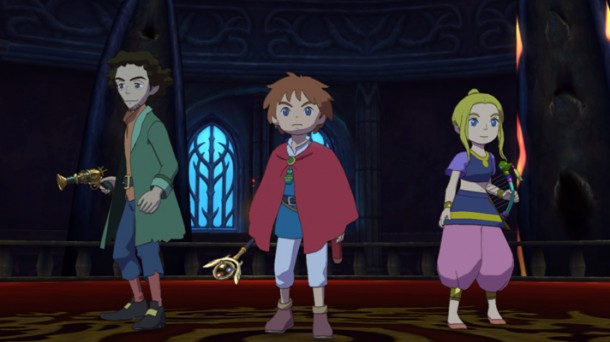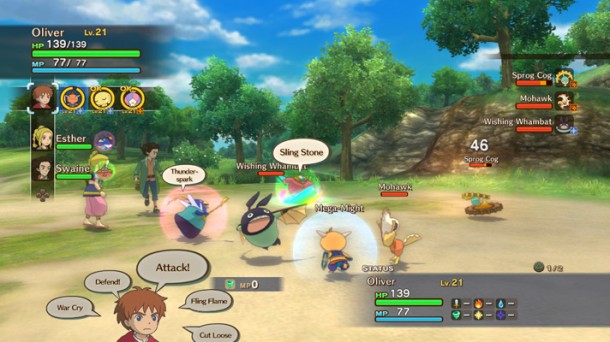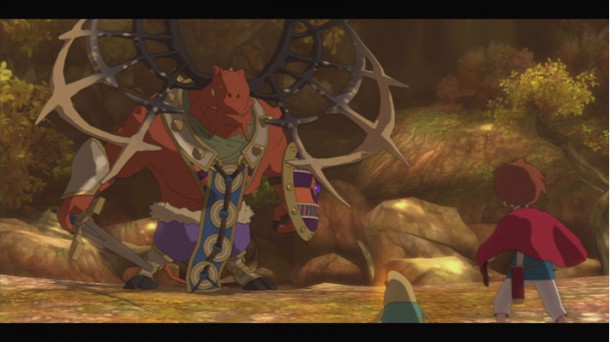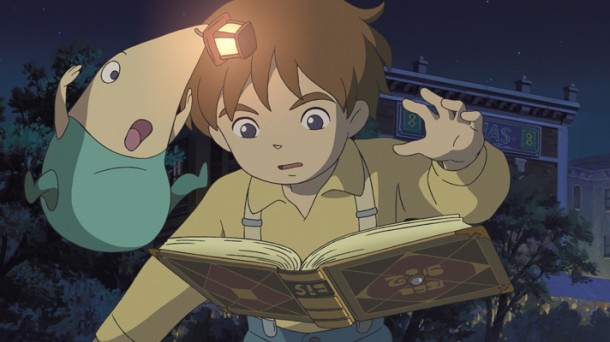What would you do if your parents suddenly died? What if you were given the chance to bring them back? How far would you go to do so? Ni no Kuni: Wrath of the White Witch brings renowned animation house Studio Ghibli together with Level-5 (Professor Layton, Rogue Galaxy) and tasks players with answering these questions, but probably not in the way they intended.
Thirteen-year-old Oliver’s journey begins a few days after the sudden death of his mother. He’s transported to a parallel world by doll-turned-Lord-High-Lord-of-the-Fairies, Mr. Drippy, and given one not-so-simple task: Defeat the Dark Djinn, Shadar, to bring his mother back. It’s an interesting premise that constantly tugs at the players’ heartstrings and, like everything else in Ni no Kuni, it works… mostly. Ni no Kuni has a lot to live up to as a love letter to both old-school RPGs and the Studio Ghibli films that came before it. What’s presented is a semi-classical JRPG brimming with ideas that often struggle to come to fruition.

Ni no Kuni is very text heavy, for better and for worse, with very little voice acting. Dialogue is well-written for the most part, especially your fairy cheerleader, Mr. Drippy, who reads like a character from “A Clockwork Orange.” Unfortunately, he can be a bit overbearing at times. He interrupts every single boss battle with useless tips and constantly holds your hand when it comes to solving quests.
Quests themselves are bookended by long, boring monologues with zero consequence to the world around you. It was a missed opportunity to teach the players about the alien world they’re travelling. In fact, the game only seems to do this whenever Mr. Drippy feels necessary. I believe they intended it to be part of his character – to forget to divulge information to the players – but it comes off as Level-5 scrambling to make up new rules in their own universe.
On the greener side of the fence lies the Wizard’s Companion, the mystical book of spells that Oliver rebuilds as his adventure continues. This 340-page tome is constantly updated with new information about the world, from monsters you encounter, spells you learn, to items you craft, and even fairy tales passed down through generations. It’s a small, barely used part of the game that adds so much depth to the world for those willing to delve through its pages. It’s a shame they couldn’t have incorporated more of it into the game beyond a few optional events.
The voice acting is serviceable, with the exclusion of Mr. Drippy, who is on an entirely different level of amazing voice acting than the rest of the cast. Unfortunately, there’s barely any of it beyond the opening, ending, and the anime cutscenes sprinkled throughout.

Gameplay is a similarly mixed bag of good and bad. Combat is simply a mess, compounded by the fact that the party AI is downright idiotic and most mechanics simply don’t work. Ni no Kuni incorporates a combination of real time and turn-based combat which, once again, only somewhat works. Oliver and company summon creatures known as familiars, which lie deep within their hearts. After a certain amount of leveling, players can evolve their familiars into stronger forms at the cost of returning them back to level one.
Players are able to freely move party members and their familiars around the battlefield, but all actions are delegated through a sloppily implemented menu wheel. Each party member can have a reserve of three familiars to freely switch between, but each shares the same health and magic gauge.
This leads to the next problem: the party A.I. I almost can’t even begin to describe how bad the party A.I. is in Ni No Kuni.
While the computer is controlling the rest of your party, each member will endlessly cast spells, quickly draining them of MP and forcing them to sit around, do nothing and/or die. You have an option to change their tactics (which, unfortunately can only be done while in battle) but the options are so limited that it’s of no use.
Partway through the game you learn the ability to tell your party members to either go all out and attack or reserve MP and defend with the press of a button. Unfortunately, even this doesn’t seem to work properly.
Most often, during an all out attack, my party members would switch to their defensive familiars and do nothing. The only way to get them to use a stronger familiar was to manually switch it myself, which completely defeats the purpose of the function.
Eventually, you’re also given the option to tame wild monsters. Only one party member can do this and you have to be actively controlling her to do so. Taming works as expected, but for a game about catching and developing monsters, I found the capture rates to be obscenely low.
Outside of battle there’s not much to do besides travelling from points A to B. Quests are plentiful but accomplish nothing but inflating your play time. On his journey to defeat Shadar, Oliver gains a special locket that can be filled with pieces of people’s hearts. He uses them in order to fix the brokenhearted, people who have had chunks of their hearts stolen by the Dark Djinn. For example, a woman might think of divorcing her husband because she lacks the ability to love. Oliver must find a piece of love from someone who has extra love to share, and use it to mend the woman’s broken heart. It’s an interesting system that’s unfortunately delegated to simplistic fetch quests. The game also pinpoints people with excess emotions on your map so there’s never any challenge. To add to this, most of the pieces you look for are already in the same town the quest originates from, so you rarely ever have to “search” for the person.

The real clincher here is how the game goes about accepting these types of quests. First, Ollie must accept the quest. Then Mr. Drippy will tell you exactly what component of the heart is required, in case you couldn’t figure it out on your own. Afterwards you must collect the piece of heart by talking to another individual; listen to Mr. Drippy once more tell you that this is the piece of heart you require; then talk to the person again to bring up your spell menu. After you cast your spell and obtain the piece of heart, you must return to the brokenhearted and talk to them again; listen to Mr. Drippy once more tell you what piece to use; then cast a different spell to mend their heart. To add insult to injury, Mr. Drippy’s dialogue never changes. He will say the exact same thing whether it’s your first brokenhearted or your fiftieth. This amount of handholding is almost insulting, especially since there are no actual puzzles in the game.
One thing that Ni no Kuni absolutely excels at is charm. This game is unequivocally Studio Ghibli which, for someone who doesn’t necessarily like their movies, came as a surprise when I realized how smitten I was.
The animations are particularly telling. Oliver jogs down steps one-by-one with the enthusiasm of a small child; characters shiver as they travel through the frozen winter isles; Mr. Drippy constantly dances around the battlefield and even while you’re idling around town; and you can even run him over accidently, to which he will roll backwards until he flops on his belly. It’s these types of small details that brought me deeper into the world.
The world is also large and varied. From the cobblestone streets of Ding Dong Dell to the walled city of Hamlet, and even to a tomb where visitors are cursed and turned into frogs, each place feels unique unto its own. The world map itself is one of the most impressive I have ever seen in a JRPG in terms of sheer detail. Deserts ebb and flow with blistering dunes, mountains shoot upward towards the sky, and valleys sink deep into the earth. This effect is multiplied tenfold once you’re able to soar through the sky. It seems like such a basic thing to behold, but the effect was so profound – especially in conjunction with renowned composer Joe Hisashi’s beautiful score.

Clocking in at around 50 hours, Ni no Kuni seems to succeed at very little. The plot is poorly paced with even the titular White Witch seeming like little more than an afterthought. The game coddles you throughout its entirety, the writing misses more than it hits, and the battle system is simply no fun. And yet, I cannot bring myself to truly hate this game. I found myself returning every day, not because I had to, but because I honestly wanted to. Perhaps it just goes to show a game can be a fundamental failure, but hold enough charm that it could melt even the most frozen of hearts. Or maybe I just have Stockholm syndrome. Yeah, probably that.
This review is based on a retail copy of Ni no Kuni purchased by the reviewer for the Playstation 3.


No Comments